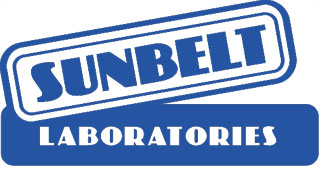The CDC is responding to an outbreak of respiratory disease caused by a novel (new) coronavirus that
was first detected in China and which has now been detected in almost 90 locations internationally,
including in the United States. The virus has been named "SARS-CoV-2" and the disease it causes has
been named "coronavirus disease 2019" (abbreviated "COVID-19").
Sunbelt Laboratories has a number of disinfectants that, based on the EPA Emerging Viral Pathogen
Policy, can be used during the COVID-19 outbreak. These products have demonstrated effectiveness
against viruses similar to 2019 Novel Coronavirus (2019-nCoV) on hard, nonporous surfaces. Therefore,
these products can be used against 2019 Novel Coronavirus (2019-nCoV) when used in accordance with
the directions for use against the appropriate virus listed for each product in the following table. Refer
to the CDC website https://www.cdc.gov/coronavirus/2019-nCoV/
for additional information.
The products listed below for use, in accordance with label directions. All products have a 10 minute kill
claim unless otherwise noted.
| Disinfectant | EPA Reg No. | Appropriate Virus Directions | Dilution Rate | Contact Time |
|---|
| SL-641 | 1839-95 | Norovirus (Norwalk Virus) | 2 oz/gal | 10 minutes |
| SL-659 | 1839-86 | Adenovirus Type 5 | 3.5 oz/5 gal | 30 seconds |
| SL-315 | 1839-168 | Human Coronavirus | 4 oz/gal | 10 minutes |
| SL-651 | 1839-168 | Human Coronavirus | 4 oz/gal | 10 minutes |
| SL-652 | 1839-168 | Human Coronavirus | 4 oz/gal | 10 minutes |
| Disinfectant | 706-111 | Poliovirus | | 5 minutes |
| Germicidal Spray | 706-65 | Adenovirus | | 10 minutes |
| [Quick Clean][ ] | 1839-220 | Human Coronavirus | | 30 seconds |
World Health Organization (WHO) studies have shown that SARS-CoV-2 may last for a few hours or
several days on surfaces, depending on the kind of surface, temperature, and humidity. Under the
conditions in at least 1 experiment, the virus remained active on plastic and stainless steel for 2–3 days.
Frequently Asked Questions:
How do I use disinfectants against coronavirus?
The CDC recommends pre-cleaning surfaces before using a disinfectant. All disinfectant label
instructions should be followed carefully, especially with regard to: Contact Time, or amount of time
that the surface must stay wet to ensure that germs are killed, Concentration, as some products may
need to be diluted before use, Application method, including whether to use a sponge, paper towel,
microfiber cloth, etc. and Personal protective equipment and other safety considerations, Suitability for
use on different Types of surfaces (see question #3 below).
Can I use disinfectants in an electrostatic sprayer, fogger, or mister?
In order for a disinfectant to be effective, it must be applied as a wet spray. Most disinfectants
recommend a coarse wet spray. This can be achieved by use of a spray bottle, pump up sprayer, or an
electrostatic sprayer. The key is that the particle size of the droplets must be greater than 80 microns,
and most electrostatic sprayers are 80–150 microns. Check the specific disinfectant label for further
instructions on use in these machines. Foggers and or misters create a thick fog or—in the case of
thermal foggers—steam and use very little product. This is an insufficient delivery system for
disinfectants.
What surfaces should I disinfect?
All reachable hard, non-porous surfaces should be disinfected, but high-touch surfaces should be paid
special attention to. These include but are not limited to tables, doorknobs, light switches, countertops,
handles, desks, phones, keyboards, toilets, faucets, and sinks.
